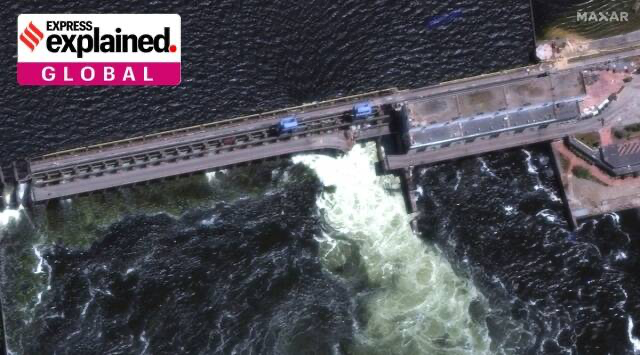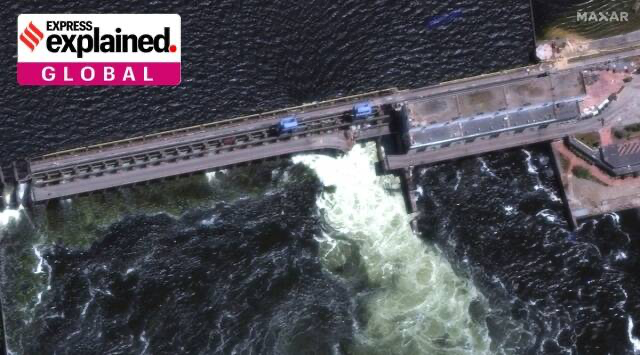Description

Disclaimer: Copyright infringement not intended.
Context
- The breach of a Soviet-era dam on the Dnipro River in southern Ukraine.
Details
- Description of a breach in a Soviet-era dam on the Dnipro River in southern Ukraine.
- Disputed accounts between Ukraine and Russia regarding the cause of the dam's destruction.
The Kakhovka Dam:
- Built in 1956 as part of the Kakhovka hydroelectric power plant.
- 30 meters tall and 3.2 kilometers long.
- Reservoir supplies water to the Crimean peninsula and the Zaporizhzhia nuclear plant.
Conflicting Accounts:
- Ukraine's perspective: Ukraine accuses Russia of destroying the dam. President Zelenskiy and the South Command of Ukraine's Armed Forces hold Russia responsible.
- Russian-installed officials' claims: Some blame Ukraine, alleging that the dam was shelled by Ukrainian forces. Others claim the dam collapsed due to earlier damage and water pressure.
Human Impact:
- Water levels are rising, posing a risk to thousands of people.
- Evacuations of civilians initiated on both sides of the front line.
- 22,000 people are at risk of flooding in Ukraine's Kherson region.
- Up to 80 settlements are at risk of flooding according to Ukrainian Prime Minister Shmyhal.
Impact on Crimea:
- Water levels in the canal, supplying fresh water to Crimea, may be affected.
- Crimea depends on the canal for its fresh water supply.
- Ukraine previously blocked water supplies to Crimea after the 2014 annexation, causing water shortages.
Impact on the Zaporizhzhia Nuclear Power Plant:
- The plant receives cooling water from the reservoir.
- The plant is located on the southern side, which is now under Russian control.
- The International Atomic Energy Agency states no immediate nuclear safety risk at the plant.
- Russia's Rosatom confirms no threat to the Moscow-controlled nuclear plant.

About Kakhovka Dam
- The Kakhovka Dam is a Soviet-era dam located on the Dnipro River in southern Ukraine.
- It was built in 1956 as part of the Kakhovka hydroelectric power plant.
- The dam is approximately 30 meters (98 feet) tall and spans a length of 3.2 kilometers (2 miles).
Purpose and Functionality:
- The primary purpose of the Kakhovka Dam is to generate hydroelectric power.
- It is an integral part of the Kakhovka hydroelectric power plant, contributing to Ukraine's energy infrastructure.
- The dam also serves as a water reservoir, supplying water for various purposes, including irrigation and industrial use.
Significance for Crimea:
- The reservoir created by the Kakhovka Dam supplies water to the Crimean peninsula.
- Following Russia's annexation of Crimea in 2014, the region has become dependent on the dam for its freshwater supply.
- Interruptions or disruptions in the water supply from the dam can lead to water shortages in Crimea.
Conflicting Accounts of Destruction:
- Ukraine's perspective: Ukrainian officials, including President Volodymyr Zelenskiy, accuse Russia of destroying the Kakhovka Dam.
- Russian-installed officials' claims: Some Russian-installed officials allege that Ukraine shelled the dam, damaging its hydraulic valves.
- Alternative Russian accounts: Other Russian-installed officials claim that the dam collapsed due to earlier damage and water pressure.
Human Impact and Evacuations:
- With the breach of the dam, there is a risk of flooding in the surrounding areas.
- Evacuations of civilians have commenced on both sides of the front line.
- Around 22,000 people in Ukraine's southern Kherson region are at risk of flooding, and up to 80 settlements are potentially affected.
Impact on Crimea's Water Supply:
- The rupture of the dam raises concerns about the water levels in the North Crimea Canal.
- The canal carries fresh water from the Dnipro River to the Crimean peninsula.
- Crimea's reliance on the canal for freshwater makes it susceptible to water shortages if the canal's water levels decrease.
Nuclear Plant and Safety:
- The Zaporizhzhia Nuclear Power Plant, Europe's largest nuclear power plant, relies on the reservoir for cooling water.
- The plant is located in the southern area now under Russian control.
- The International Atomic Energy Agency (IAEA) has stated that there is no immediate nuclear safety risk at the Zaporizhzhia plant, and Russia's state nuclear energy company, Rosatom, has confirmed there is no threat to the plant.
|
PRACTICE QUESTION
Q. Which of the following rivers drain to Black Sea?
1. Volga River
2. Dnieper River
3. Yenisei River
4. Lena River
Select the correct answer using the codes below:
(a) only 1
(b) only 2
(c) only 3
(d) All four
Answer: B
|

https://indianexpress.com/article/explained/explained-global/kakhovka-dam-ukraine-russia-war-8648412/












